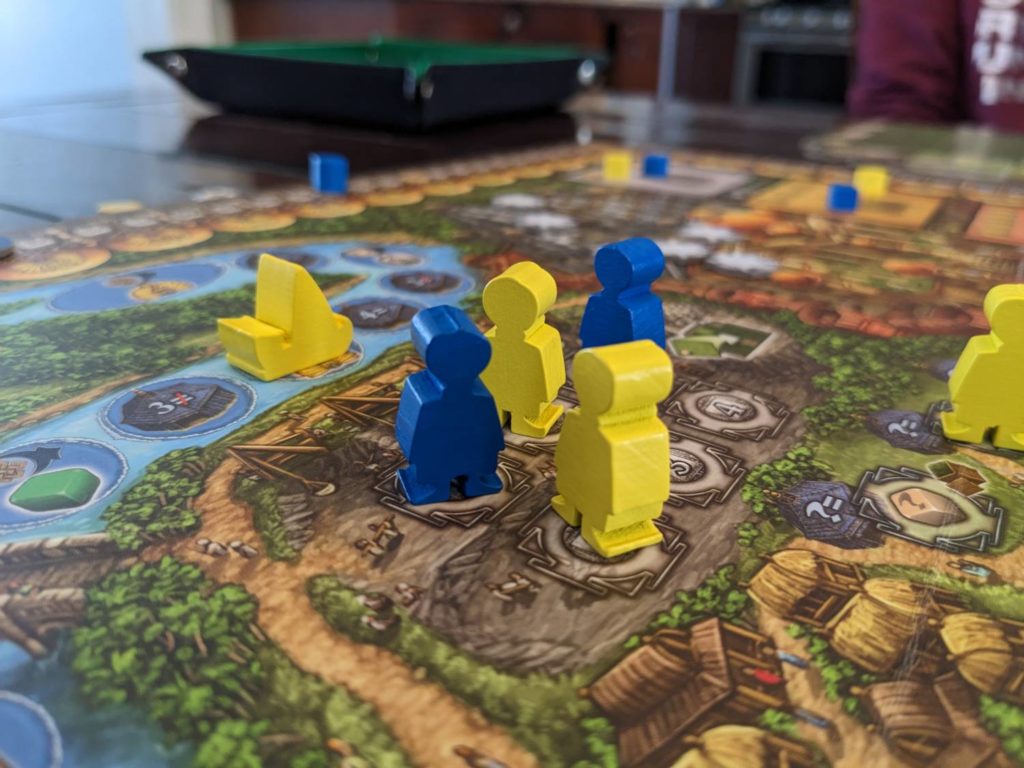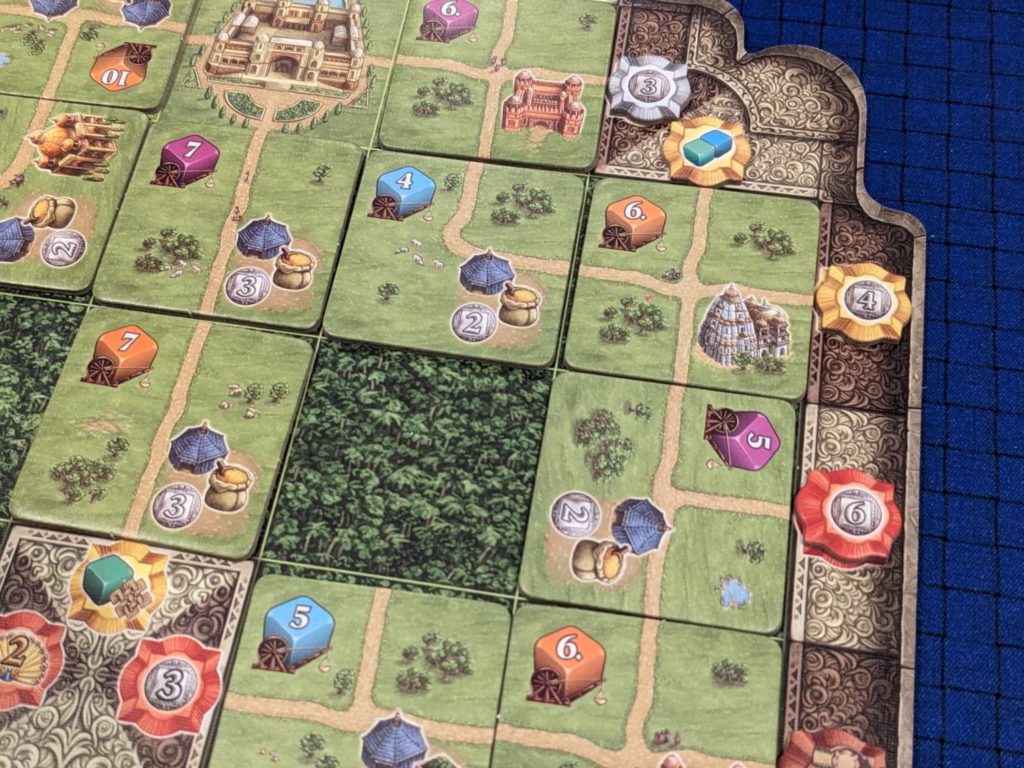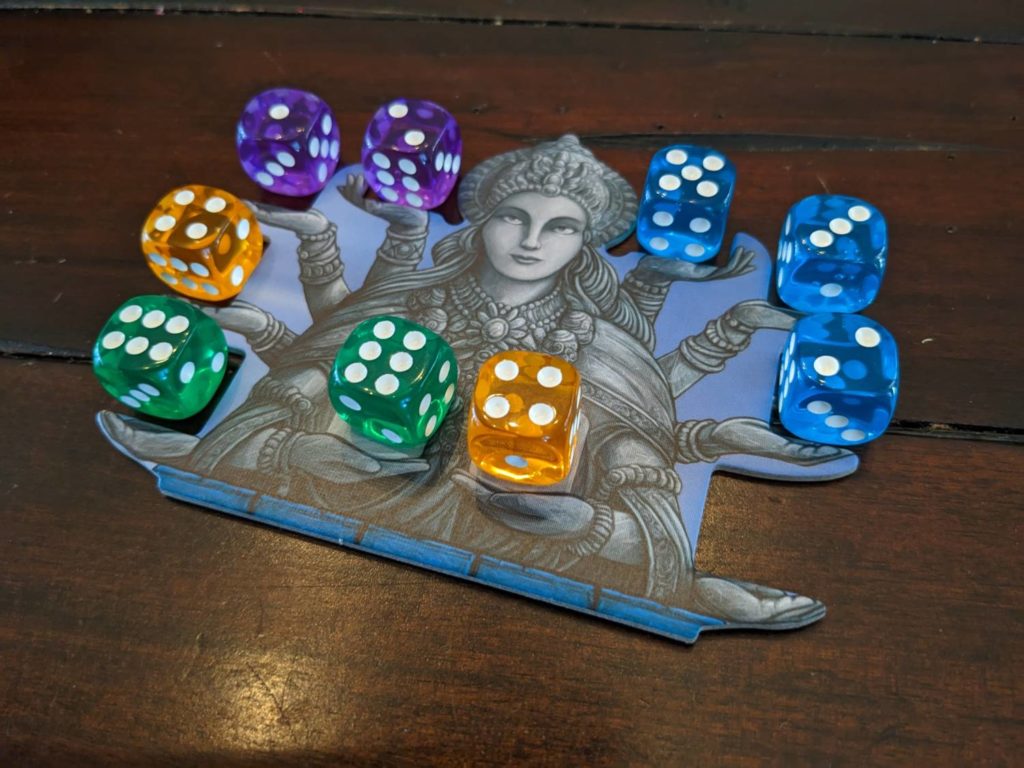I was strolling PAX Unplugged’s 2021 event, and while I was chatting with Dan DiLorenzo at R&R Games about Witchstone, we walked around his booth.
Dan walked into one edge of the booth and pointed at a title. “Trust me, this one always does great. I still play it, even today,” Dan shared as he showed me a copy of Rajas of the Ganges. “I don’t even use all of the expansions; the base game is just a classic.”
Rajas of the Ganges was released all the way back in 2017 but is still the kind of delightful, non-confrontational Euro that I can get my wife to play, and it scales well at all player counts by providing the snappy turns and non-existent round clean-up I love. AND it has great-looking dice! Now I see why Rajas of the Ganges is so reliable.

Worker Placement? Check
Rajas of the Ganges—which we’ll just call Rajas for this review—was designed by Inka & Markus Brand, the brains behind such well-regarded classics such as Village and Recto Verso as well as the Exit: The Game (I have a particular fondness for Exit: The Game—Advent Calendar: The Hunt for the Golden Book) series. Like these escape room in a box experiences, I found myself nodding and saying “huh, interesting” a bunch during my plays of Rajas.
That’s because play is so straightforward. Each player begins with a set of three workers, a boat, a Kali statue, a pool of four dice—one in each of the game’s four dice colors, purple, orange, blue and green—and a province board. The statue is used to hold as many as ten of each player’s dice. The province board will be used to build tiles connecting outward from the pre-printed palace on this separate player board.
The starting player then places a worker in one of the main board’s four areas:
- The quarry, where players can spend their dice to build a tile on their province board;
- The market place (NOT marketplace!), where players can receive a large boost of cash;
- The palace, where dice and workers can be used to gain benefits;
- The harbor, to push the boat ahead on the river spaces.
Generally, the palace is where one goes to get dice; the quarry is where you’ll build one of the 12 face-up tiles from the market into your tableau. The harbor is a series of spaces that all generate benefits, so moving a player’s boat forward always yields positive results, and the market place can really pay well if a player specializes in one of the game’s three goods: silk, tea, and spices.
The upper left-hand corner of the board has a “karma” section. This is where players can spend karma as a free action to flip a die to its opposite face. In this way, you can mitigate your way out of ones and twos to make sixes or fives, respectively, which increases your buying power when going to the tile market.

The beauty of Rajas is that players are never blocked out. Truly, never. Many of the worker placement locations have no cost. Others have a cost, but that cost can be any color die. Money is never a major issue in Rajas, so even when you have to spend a few coins to use an action—the earlier you visit a section of the board, the lower the cost—you should still be able to make turns a net positive experience.
Once each player has run out of workers, the round ends and a new one starts with the player to the left of last round’s start player, unless someone used the Great Mogul space in the palace to select becoming the first player by using a worker. Additional workers can be added by passing certain spaces on the fame and/or money tracks, or by advancing far enough along the spaces on the river with their boat token.
A game of Rajas ends by using a scoring condition similar to more recent games like 2018’s Crown of Emara as well as 2021’s Ark Nova, where two different scoring markers going in opposite directions on the board must pass each other. In Rajas, you’ll be tracking money and fame (victory points) on two separate tracks winding around the outside of the game board in opposite directions.
When a turn ends with one player’s markers passing each other, that’s the final turn of the game. Each other player then gets one last turn if they have any workers left. If multiple players have their scoring markers pass each other on the same turn, then the person who created the largest separation between their markers takes the win.

Slick
The elegance of Rajas comes down to the smooth nature of each turn. You place a worker, and it does the exact thing you expect it to do, then you move to the next player. New dice get added and rolled right away, so everyone knows where everyone stands with their pool of choices every turn.
Even on my first play, it was rare for a turn to take longer than a minute. The choices are rich but uncomplicated; it’s clear that specializing in certain kinds of goods markets, tile types, and/or buildings can yield big benefits.
Rajas is a bit “heads-down”; the level of interaction between players is low. With a market that consistently offers players 10-12 tiles to place on their province board, players usually have choices on how to spend their dice. Blocking a specific slot and keeping someone out of an area is really hard, even in the two-player version of Rajas (which uses one side of the double-sided game board). That makes Rajas perfect for a game group or a couple looking to conduct a Euro scoring puzzle without any legitimately mean playstyles.
Not once did I hear a player gripe “ahh, I was gonna take that spot!” without quickly following that with a “oh, wait, I guess I could ___ over there instead” response. I love that players can always accomplish their goals, but long for moments where there would be a little more conflict.
The board is a bit busy—the artwork is only OK. The four building types are not distinct enough, so sometimes I found myself double-checking the board to see which track I was really moving up or scoring when I placed tiles. The palace has the majority of the game’s actions, but it is a mistake to ignore any one section, meaning that the entire series of worker placement spots have real value. Well, except for one. The Master Builder in the palace, which allows you to overbuild tiles in your tableau, rarely (if ever) gets used. One wishes it were a more useful action instead.
Rajas is incredible, and the game was just as much fun for me with two players as it was with three or four players. There are two mini expansions in the box that can make the game slightly more challenging, balance play for experienced and new players, or incorporate more variety in the choices along the river spaces. I don’t even need those expansions yet—the base box alone is a midweight gem with ridiculous amounts of replayability. Without a doubt, Rajas is a keeper.












Add Comment